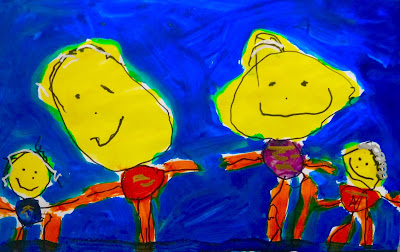What I really love about working with the children on their art pieces is watching how they interact with the materials, how they notice and enquire about the work of their peers, and how children when supported with time and space begin to ‘think like an artist’.
Often when
I work with children on any art related experience I encourage them to ‘think
like an artist’. Although as adults we may ponder too much over how to do this,
for children I find it comes quite naturally. So how do artists think? I’m
actually not much of an artist myself despite it being very much embedded in my
teaching practice, so to answer this question I have to look at what artists
tell me,
Artists often look at things more closely than
most people do. They tend to notice things that others might miss, often with
the eyes of a child...Artists also tend to look at things in different ways,
often without using labels…when artists sit down to draw or paint a scene they
look at the objects as shapes and lines, not as trees or noses. They notice how
the shapes and lines are related to each other; they look at spaces between
shapes; they look at shadows... (Mulcahey, 2009)
It is with
that statement in mind that we often find ourselves at Mairtown returning to
the work of Hundertwasser. His work is delightfully colourful, rather abstract
and children are naturally drawn to his pieces, all interpreting his work in
very individual ways.
For some, art and creativity comes more instinctively than it does for others, however
I still encourage all the children to ‘think like an artist’. As I work with
the children either in small groups or individually, I’ll encourage them to
take a risk, to experiment and try out their ideas, as that is how we gain the confidence
that anything is possible; I’ll encourage them to look at things in different
ways, as that is how we learn that everyone sees the world differently; and as
I perhaps do more frequently than anything, I’ll encourage the children to
dream and imagine, to tell stories, to think about what it could be rather than
what it is, as this strengthens our imaginative and critical thinking skills.
Artists often take risks with their work since
more will be gained by taking a risk than not. We expose ourselves to risk any
time we begin a work of art. Children do the same. Will it turn out the way
they want it to? Will they be able to control the paint? What if they don’t
like it? As [adults] we need to reassure the child that risk is a good thing
and that mistakes are learning experiences (Mulcahey, 2009)
Although we may have used Hundertwasser’s art as a provocation for the children’s work, I feel it is still vital for the children to make choices. In this year’s work, many children decided not to use Hundertwasser but created work from their imaginations. Those that did were given Hundertwasser books and left to browse his pictures until they settled on one that inspired them. In doing this all the children’s work has turned out differently. Some children have painted Hundertwasser's famous lollypop trees in an expanse across their paper, others have painted only one, some children included themselves in their picture, some have created buildings and others patterns. Each child has approached his/her creation differently; there was no right or wrong way to begin or to finish and as such the pieces once again this year are totally stunning.
Providing open-ended experiences based on adult
artwork gives children a rich exposure to art and a rich exposure to art experiences.
Children are learning and doing at the same time. As children look at examples
of works of art that initially inspires them, their visual perception skills
are being nurtured (Douglas et al., 1981).
I wish I could show you all the finished pieces, but for now I have included some of the stunning and beautiful final art works for you to see.



































3 comments:
What stunning artwork and evidence of the planning and thoughtfulness of the teaching team in planning this activity. It is great to read of the supports provided to the children in this activity - art as a provocation, tools to create and the freedom of imagination. Tumeke!
Hello From Australia. All I want to do is come and join in with your amazing art program. I too am an early childhood teacher, and I am truly inspired about the details and knowledge you are extracting from these children.
I have only just found your blog, and am looking forward to reading, and seeing more.
I am also interested in reading some of the texts/journals you quote from. is it possible for you to post these at some point?
Kindest Regards,
Lisa
As a fellow early childhood teacher, I am truly stunned by these artworks. Your blog gives me such inspiration, one day I would love to visit your centre. Thank you so much for sharing your wonderful work
Lisa
Post a Comment